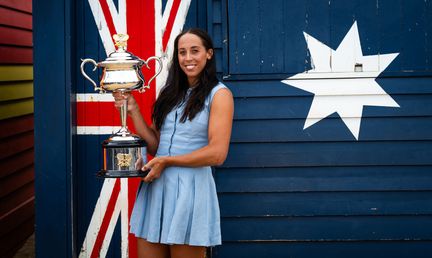The top two seeds, one of the game's biggest servers and a former champion are your remaining four at the All England Club. It goes without saying that Ashleigh Barty, Angelique Kerber, Aryna Sabalenka and Karolina Pliskova each has the game to walk away with this year's Wimbledon title, but it's going to take a strong effort.
"I certainly don't become complacent in any facet of my game thinking I know what's going on," Barty said Tuesday after her quarterfinal win. "Sport is a wonderful thing in a sense where there's no guarantees, no certainties. That's what makes it so incredible to play and be a part of."
Kerber, too, spoke of the mental strength that has carried her this far.
"I was never stopping believing in myself, in my team," she said. "For me, I love to play tennis and I love this sport, to go out there and play again in front of the fans."
On Thursday, Barty will take on Kerber, while Sabalenka squares off against Pliskova.
What are the keys for the four semifinalists? Our writers weigh in.
No.1 Ashleigh Barty vs. No.25 Angelique Kerber
Key for Barty: Win the court-position battle
The World No.1 is into her first Wimbledon semifinal and first major semi since the Covid shutdown. The good news for Barty is that her quarterfinal 6-1, 6-3 win against Ajla Tomljanovic was the best performance of the fortnight. Barty has lost just one set so far, in her opening round against Carla Suárez Navarro, but she has otherwise been business-like in her march to this stage.
Barty and Kerber have split their four prior meetings, but they have not played since 2018, and we have yet to see them face each other while simultaneously in form. That will change Thursday.
Barty came into Wimbledon under an injury cloud. She retired in the second round at Roland Garros with a hip injury, but her trademark agility and skill in and out of the corners has been sharp. She has played 70 points of nine or more shots and won 44 of them, proof she's ready to play long rallies and wait for the right moment to strike.
Against Kerber, Barty will need to serve well and manage her 1-2 punches to get quick holds and pressure Kerber's service games. When Barty has had success against the German, she's been able to pull Kerber into the tramlines and open up the court for her forehand. Pulling Kerber into the net to set up a lob has also been a reliable play. In short, this will be a battle for court position. Can Barty push Kerber off the baseline and open up the angles?
The biggest question for Barty is to what extent she can elevate her game. Through her five matches, Barty has faced just one opponent in the Top 60. That came in the Round of 16 against No.17 Barbora Krejcikova. The Czech started well with an early break, but Barty never panicked. She used the first few games to get a measure on Krejcikova and then rolled to a 7-5, 6-3 win. That performance was a sign of Barty's confidence in both her game and her body. -- Courtney Nguyen
Key for Kerber: Stay inspired
During the press conference following her 2018 Wimbledon title, Kerber pointed to her new All England Club membership badge -- a rare moment of swagger for the level-headed German.
But for nearly three years afterward, she did not reach a Grand Slam quarterfinal and had no titles at any level. “I was not being able to have this result which I was actually looking for,” Kerber said Tuesday.
Once the tour returned to grass this season, Kerber flourished. She finally collected another title, on her homeland lawns in Bad Homburg, and now, 10 days later, she’s riding a 10-match winning streak into the Wimbledon semifinals.
“I really enjoy to play on the Centre Court here,” Kerber said. “It's more like the feeling how to play on grass court, how I feel three years ago. I remember how I played here.”
Being back on grass, and at Wimbledon in particular, allows Kerber to hype herself up. When she hits SW19, Kerber has no problem buying into her own talents. In her run to the semifinals, she has showed an unwillingness to demonstrate anything less than her best.
This is what it means #semifinal ❤️ @wimbledon pic.twitter.com/xHvt2hZYHg
— Angelique Kerber (@AngeliqueKerber) July 6, 2021
The hallmarks of the Kerber game are all still present. She does not appear to have lost a step since 2018, and she is getting as low to the ground as ever. Her signature directional changes of the ball are heavily scouted, yet by the time those shots register on court, it’s often too late for her opponent.
A gritty second-round match against Sara Sorribes Tormo -- the longest and arguably best encounter of the tournament -- only seemed to elevate Kerber's game. In her past two matches, against Coco Gauff and Karolina Muchova, Kerber did not drop a set.
The key for Kerber is to continue using Wimbledon’s unique aura to inspire her into executing her undiminished strengths as if this were an extension of 2018 rather than 2021. If she keeps believing, she could find herself a two-time Wimbledon champion come Saturday. -- Jason Juzwiak
No.2 Aryna Sabalenka vs. No.8 Karolina Pliskova
Key for Sabalenka: Leverage her well-rounded game
Did Sabalenka really have a mental block in Grand Slams, or just bad luck? Since cracking the Top 10 at the start of 2019, she has won eight WTA Tour titles, but Wimbledon marks the first time she has progressed beyond the fourth round of a major. Dig deeper, though, and few of her Grand Slam losses were egregiously bad. She lost two matches against prodigy Amanda Anisimova (Australian Open and Roland Garros 2019); three against tricky opponents who disrupted her raw power (Magdalena Rybarikova, Wimbledon 2019; Yulia Putintseva, US Open 2019; Ons Jabeur, Roland Garros 2020) and two to multiple Grand Slam champions (Victoria Azarenka, US Open 2020; Serena Williams, Australian Open 2021).
A third-set whitewash against Anastasia Pavlyuchenkova at Roland Garros last month told a different story, though, as does Sabalenka herself.
"I was struggling on the Grand Slams with all emotions going through," she said after defeating Jabeur in Tuesday's quarterfinals. "After every Slam, I was so disappointed about myself that I can't handle this pressure."
The truth lies somewhere in between. Sabalenka is simply a better player now than she was when she lost to Jabeur in September 2020, let alone in 2019. The Belarusian is more well-rounded. The skills she has learned in winning two doubles Grand Slams with Elise Mertens are paying off, particularly in terms of touch and reflexes at net. She has broadened her artillery beyond brute force, with the drop shot a welcome addition this year.
Crucially, Sabalenka is also more focused. Her performance against Jabeur may have been one of the most disciplined of her career. Sabalenka showed no lapses in concentration against the Tunisian and was quick to adapt to everything she faced.
Plenty of players emerge on to the WTA Tour with raw power. But over the years, Sabalenka's commitment to adding to her game has been the reason she has become a Top 10 mainstay, not just a hit-or-miss upset artist. At Wimbledon, both her tennis and her mind have taken another step forward -- and there's no reason it can't be a step all the way to the title. Even if that's not this year, the Sabalenka learning curve is still on an upward trajectory. -- Alex Macpherson
Key for Pliskova: Continue to serve big
It’s harder and harder to find these days. Unless you’ve been watching Karolina Pliskova at Wimbledon.
When the No.8 seed was asked what the key to her 6-2, 6-3 quarterfinal win over Viktorija Golubic, she answered, “There were a couple close games which I handled well. My serve was extremely good today, I would say.”
And that is what needs to happen again for Pliskova in the semifinals against Sabalenka. They are both huge hitters, but because Sabalenka is so athletic, it’s Pliskova’s serve that must put her over the top. Sabalenka leads the head-to-head 2-0, but the third set scores in those matches were 7-6(5) and 7-5.
As Sabalenka observed in her post-match press conference, “She’s moving well right now. She’s hitting balls really solid and serving well.”
This is what it means #semifinal ❤️ @wimbledon pic.twitter.com/xHvt2hZYHg
— Angelique Kerber (@AngeliqueKerber) July 6, 2021
Pliskova has won 42 of 45 service games, good for 93 percent. Her flat offerings stay so low on the grass they never seem to come up into proper striking range. Pliskova’s 40 aces lead the tournament, ahead of Barty (38) and Sabalenka (34).
Of course, big serves have a big downside -- double faults. Pliskova also leads in that category, with 26, but they haven’t hurt her badly. Under duress, as Pliskova herself noted, she’s been solid, saving 18 of 21 break points. Her toss has given her trouble in recent weeks, but Pliskova has managed her nerves well. She has yet to see a seeded player this fortnight, so the No.2 seed Sabalenka represents a higher-level challenge.
“It’s going to be big match because she goes for big, big shots, big game, big serve,” Pliskova said of Sabalenka. “I think there’s not going to be much time to think about, 'What should I do? What should I not do?’ Just quick decisions.
“But I believe I have also a game which can bother her a bit. Big serve. I need to play fast, just put pressure on her.” -- Greg Garber








